
|
You entered: new moon
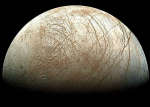 Gibbous Europa
Gibbous Europa
15.12.2013
Although the phase of this moon might appear familiar, the moon itself might not. In fact, this gibbous phase shows part of Jupiter's moon Europa. The robot spacecraft Galileo captured this image mosaic during its mission orbiting Jupiter from 1995 - 2003.
 Charon Flyover from New Horizons
Charon Flyover from New Horizons
14.08.2017
What if you could fly over Pluto's moon Charon -- what might you see? The New Horizons spacecraft did just this in 2015 July as it zipped past Pluto and Charon with cameras blazing.
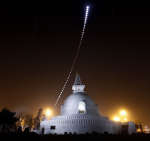 A Lunar Eclipse Over an Indian Peace Pagoda
A Lunar Eclipse Over an Indian Peace Pagoda
14.12.2011
Our Moon turned red last week. The reason was that during December 10, a total lunar eclipse occurred. The above digitally superimposed image mosaic captured the Moon many times during the eclipse, from before the Moon entered Earth's shadow until after the Moon exited.
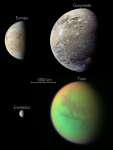 Potentially Habitable Moons
Potentially Habitable Moons
19.09.2014
For astrobiologists, these may be the four most tantalizing moons in our Solar System. Shown at the same scale, their exploration by interplanetary spacecraft has launched the idea that moons, not just planets, could have environments supporting life.
18.08.2003
Last Thursday, millions of people had an unexpectedly good view of a dark night sky. Usually, the reflection of city lights off of local air impurities makes it hard for casual observers to see more than a handful of stars from a bright urban area.
 The Map of Dione
The Map of Dione
6.11.2014
This cylindrical projection global map is one of six new color maps of Saturn's midsized icy moons, constructed using 10 years of image data from the Cassini spacecraft. Discovered by Cassini (the astronomer) in 1684, Dione is about 1,120 kilometers across.
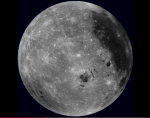 Rotating Moon from LRO
Rotating Moon from LRO
16.09.2013
No one, presently, sees the Moon rotate like this. That's because the Earth's moon is tidally locked to the Earth, showing us only one side. Given modern digital technology, however, combined with many detailed images returned by the Lunar Reconnaissance Orbiter (LRO), a high resolution virtual Moon rotation movie has now been composed.
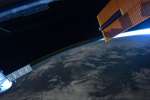 Perseid Below
Perseid Below
10.08.2012
Denizens of planet Earth watched last year's Perseid meteor shower by looking up into the bright moonlit night sky. But this remarkable view captured on August 13, 2011 by astronaut Ron Garan looks down on a Perseid meteor.
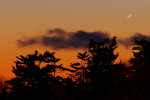 A New Year s Crescent
A New Year s Crescent
1.01.2014
That's not the young crescent Moon poised above the western horizon at sunset. Instead it's Venus in a crescent phase, captured with a long telephoto lens from Quebec City, Canada, planet Earth on a chilly December 30th evening. The very bright celestial beacon is droping lower into the evening twilight every day.
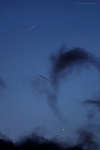 Clouds and Crescents
Clouds and Crescents
4.01.2014
A crescent Venus shines along the western horizon at dusk in this clearing sky. The Earth's sister planet is smiling between the low clouds near the bottom of the frame during its January 2nd conjunction with the slender, young crescent Moon above.
|
January February March April May June July |
|||||||||||||||||||||||||||||||||||||||||||||||||